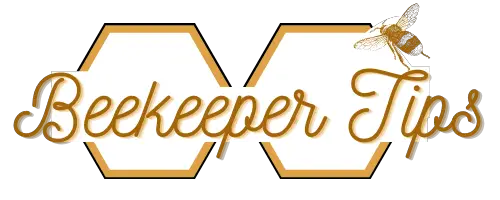If you are trying to identify a bee with an orange stripe or a bee with an orange bum, there are a few candidates, all of whom are amazing little friends to have in your garden. Let us take a look at a few candidates who meet these criteria!
Bees are in general commonly colored with yellow and black/grey strips of some sort. This can vary slightly to a yellow and black color. There are many thousands of species of bees that can be described as having an orange stripe, or an orange bum. Luckily, the most common bees that fit this description are also the ones that you are most likely to see. Some of these are solitary bees, some are bumble bees.
Table of Contents
The Orange-Belted Bumblebee/Tricolored Bumblebee
If you are based in the Northern USA or Canada, the chances are, if you saw a bee with an orange stripe it will be the Orange-belted Bumblebee – Bombus ternarius. These bumblebees are really fascinating to watch, and also to understand their biology. They are adapted to deal with a relatively cold environment and produce seasonal nests.
Learn more about: How Many Wings Does A Bumblebee Have??
In April, as it worms up in their natural range, the queen bees emerge from their hiding places. Queens have a significant percentage of their body that comprises stored fat – this fat represents an energy reserve the young mated queen can use to establish a colony.
She will typically seek out some sort of hole in the ground, and will then fly out in search of nearby flowers. She will begin to build a basic nesting site or grove. This site is lined with a waxy secretion (this melts at a much lower temperature than beeswax) and then provisions this area with pollen mixed with nectar and lays eggs into the food she has provided for her young. The young bees are then incubated by the queen. This requires that she use energy from her fat stores, as well as from nectar from flowers. She can require significant nectar resources – drawn from 5000-7000 flowers a day. Proximity to good nectar resources is consequently important in spring – you can also see how having these bees around your garden in spring is important too!!
After about a month, the first of her babies hatch – these are females and will primarily function as workers going out and collecting pollen and nectar and building up the strength of the colony. As the season progresses the colony will get quite big – up to a few hundred individuals sometimes. Towards the end of the growing season, the queen will lay some unfertilized eggs that develop into drones. Then right at the end of the season, she will lay a few more fertilized eggs – these will develop into your queens who will go out, mate with drones and then find someplace to hide for the winter. The worker bees, old queen, and drones that have not mated will then die. In spring the young queen emerges and the process begins again.
Hunts Bumblebee
There is another bumble bee that looks nearly identical to the Orange belted bumble bee and that is Hunts Bumblebee – Bombus huntii. This bee extends up the west coast of North America from Mexico, through the USA to Canada, and about halfway across the interior.
This bee has a similar lifecycle – hence it is also a bee with an orange stripe! This specific species has significant potential for domestication and use in pollination. Bumblebees are useful pollinators – highly efficient – and their method of navigation does not require them to orientate on the Sun as much as honeybees do. This means they can be used in greenhouses for pollination, whereas honeybees cannot.
Here we can see two honeybees – the one on the left is a bee with an orange stripe and the one on the right has no orange stripe. There is great color variation in honeybees. (Photo right courtesy of Dr. J. Cambray)
Apis mellifera – our old friends
This is, as we know, the honeybee! Certain races can be quite dark, and have one or two orange stripes. In this regard, in terms of finding a bee with an orange stripe on a flower – it could in fact be a honeybee as well. Look around and see if there are other bees that look nearly the same on the flowers that have different colors. Honeybees will often show quite varied coloration in a single hive. This is because of the fact that queen bees mate with a lot of drone fathers. See this article I wrote on the differences between bumblebees and honeybees.
The Bumblebees Bombus Bifarius and Bombus Vancouverensis
These bumblebees are the subject of a current taxonomical debate as to which is which and which species has what range etc. This is normal with taxonomy. However, suffice it to say, individuals of both species are quite difficult to tell apart, and some individuals have a red strip/splotch on their bums. So they may not quite be a bee with an orange stripe, but they come close!! If you did not look too closely you may think that the orange bum was an orange stripe!
Do Not Confuse Bees With Giant Hornets
Giant Hornets are common in Asia, where they are an important part of the ecosystem. A few colonies of these hornets have been found in the wild on the West Coast of North America, leading to a sort of hysteria around “Murder Hornets”. I have seen these hornets and I do not find them very scary – they are big, slow, and dumb. Yellow jackets are far scarier in my opinion. I am sure a Giant Hornet sting is memorable, but actually getting stung by one of these thumb-sized hornets is going to take some silly behavior.
Many people, in fits of paranoia mistake bumble bees for giant hornets. This is a bit like mistaking a chocolate bar for a fish, but I guess when we panic we can be stupid. For more on Giant Hornets in North America, read here.
I hope this article has helped you find a few options to help you identify a bee with an orange stripe. Whatever bee it is, consider it an honored friend and celebrate its presence in your garden!! If you enjoyed this, please share!
Read more about: How to Get Rid of Bumblebees Without Killing Them
FAQs
What is the bee with an orange bum?
There are a number of candidates, most of which are bumble bees. The bumblebees Bombus bifarius and Bombus vancouverensis (excuse lack of italics - the software does not alow it in this section) can have orange bums.
What are black and orange bees?
The vast majority of bees tend to have a banded black and orange coloration. This includes honeybees, many bumble bees, carpenter bees, many other solitary bees and even some pollen wasps.
What kind of wasp is black with orange stripes?
There are a number of wasp species with black and orange stripes. Possibly one of the more fascinating is the Giant Hornet. Ok, I know technically that is a hornet. There are many wasp species that are black and orange - with the Red and Black Mason wasp (it looks more orange actually than red) being an example that is widely spread in the US. This wasp is an excellent biocontrol of various caterpillar crop pests.
Are carpenter bees orange?
There are some that can be orange yes! There are a lot of different species of carpenter bee that can range from black, to orange to many other metallic shades! The Valley Carpenter bee can take on a completely orange fuzzy color.

Dr. Garth A. Cambray is a Canadian/South African entrepreneur and beekeeper with 28 years of experience in apiculture and specializes in adding value to honey. His Ph.D. research developed a new advanced continuous fermentation method for making mead that has resulted in a number of companies globally being able to access markets for mead. His company, Makana Meadery, exports honey mead to the USA where it is available to discerning connoisseurs. He has also developed technologies to commercially manufacture organic honey vinegar in Zambia for export globally. He holds a few patents globally in the ethanol industry and believes in technology and knowledge transfer for human development and environmental sustainability. One of his proudest achievements is the fact that the wind farm he started at one of his old apiary sites has essentially made his hometown carbon neutral.




